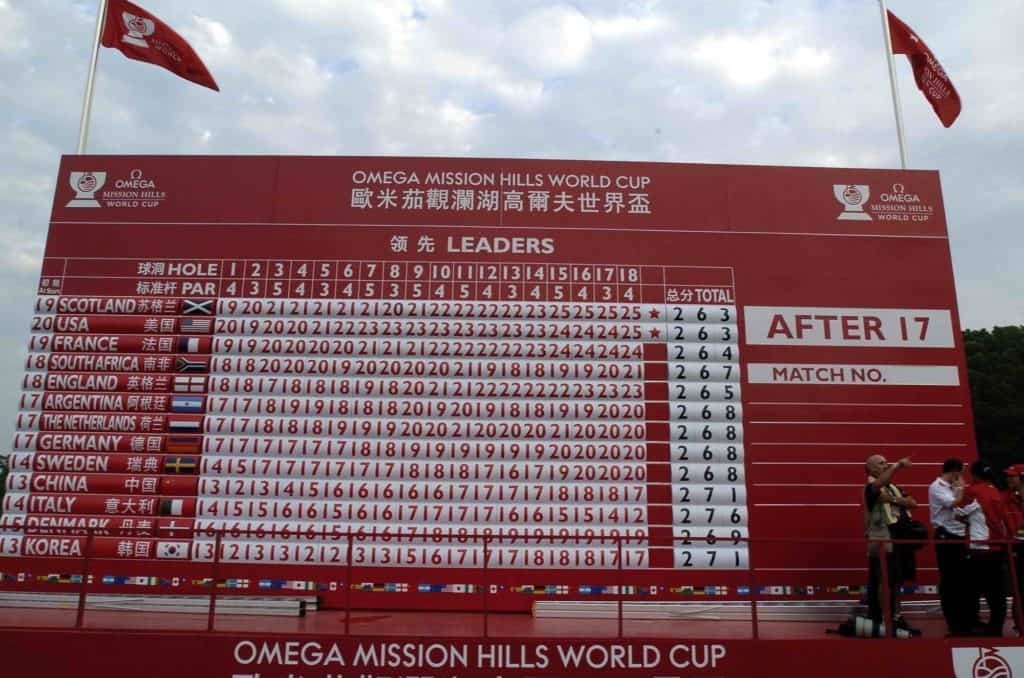What Does Mdf Mean In Golf

Welcome to the fascinating world of golf, where precision, strategy, and skill combine to create an exhilarating sport. As you delve into the intricacies of golf terminology, you may encounter the acronym “MDF” during discussions or tournament broadcasts. But what does MDF mean in golf? In this comprehensive guide, we will unravel the meaning and significance of MDF in the context of the game.
MDF stands for “Modified Stableford” or “Mostly Determined by Field” in golf. It is a term commonly used in professional tournaments to determine the cut line and field size for subsequent rounds. Unlike traditional stroke play events where a fixed number of players advance based on their scores, the MDF rule introduces a different approach.
Understanding the concept of MDF is crucial for any golf enthusiast. It represents a unique scoring system and decision-making process that shapes the course of a tournament. By delving into the details of MDF, we will explore how it affects players, the dynamics of the competition, and the overall excitement of golf tournaments.
So, join us as we embark on a journey to uncover the meaning and intricacies of MDF in golf. From its calculation to its implications, this guide will equip you with a comprehensive understanding of what MDF truly signifies in the world of golf. Let’s tee off and explore the fascinating realm of MDF in golf!

What is the Definition of MDF in Golf?
MDF stands for “Modified Stableford” or “Mostly Determined by Field” in golf. The term is primarily used in professional tournaments to determine the cut line and field size for subsequent rounds. Unlike traditional stroke play events, where a set number of players advance based on their scores, the MDF rule employs a different approach.
How is MDF Calculated in Golf Tournaments?
The calculation of MDF in golf tournaments involves a combination of scoring and field size factors. Let’s delve into the details:
Scoring System:
In MDF tournaments, players receive points for each hole based on their score relative to par. The scoring system may vary depending on the specific tournament rules, but it typically follows a modified stableford format. For example, a player might earn +2 points for a birdie, -1 point for a bogey, and 0 points for a par.
Field Size:
At the conclusion of a round, the tournament organizers compare the scores of all participants to determine the cut line. The cut line separates the field into two groups: those who make the cut and continue playing, and those who do not.
Determining the MDF:
If more players score at or below the cut line than can reasonably continue to the next round, the MDF rule comes into effect. The MDF rule adds the remaining players who would typically miss the cut, but are within a certain number of strokes from the cut line, to the field for the next round. This ensures that a more significant number of players continue to compete.
What Does MDF Signify in Relation to the Cut Line?
MDF signifies the criteria used to determine which players make the cut in a golf tournament. It ensures that a larger field advances to subsequent rounds, providing more players with the opportunity to showcase their skills and potentially improve their standing in the tournament.
The implementation of the MDF rule acknowledges that there may be a significant number of players in close proximity to the cut line. By incorporating these players into the field, the MDF rule allows for a more competitive and inclusive tournament experience.
Factors Influencing the Implementation of MDF Rule
The decision to use the MDF rule in golf tournaments depends on various factors. Let’s explore some of the key considerations:
Tournament Format:
MDF is typically employed in stroke play events where the field size is large, such as professional tournaments. The rule aims to strike a balance between maintaining a reasonable field size for subsequent rounds while allowing a fair number of players to continue competing.
Field Size:
When the field size is particularly large, the MDF rule becomes more relevant. It helps manage the number of players advancing to subsequent rounds and ensures a manageable number for logistical purposes.
Logistical Considerations:
Organizers take into account logistical factors, such as available tee times and course capacity, when implementing the MDF rule. It allows for a smoother flow of play and helps maintain the integrity of the tournament schedule.
The implementation of the MDF rule is a dynamic process that tournament organizers evaluate based on these factors and the specific requirements of each event.
Pros and Cons of the MDF Rule
Like any golf rule or scoring system, the MDF rule has its advantages and considerations. Let’s examine the pros and cons associated with the MDF rule in golf tournaments:
Pros of the MDF Rule:
- Increased Field Size: The MDF rule allows for a larger number of players to advance to subsequent rounds, providing them with more playing opportunities and exposure in the tournament.
- Greater Competition: Including more players through the MDF rule enhances the competitive environment. It fosters a sense of inclusivity and allows golfers who narrowly missed the cut to continue showcasing their skills.
- More Excitement: The MDF rule adds an element of suspense and drama to the tournament. It keeps fans engaged by extending the field and potentially giving players who were on the bubble an opportunity to make a comeback.
Cons of the MDF Rule:
- Lower Scoring Averages: The MDF rule may result in higher scores for the additional players included in subsequent rounds. This could impact scoring averages and potentially affect statistics and records associated with the tournament.
- Logistical Challenges: Including more players through the MDF rule may pose logistical challenges, such as managing tee times, course availability, and pace of play. Tournament organizers must ensure that these considerations are effectively addressed.
- Potential for Unfairness: Some critics argue that the MDF rule may create an unfair advantage for players who make the cut due to the rule’s implementation. These players may have an opportunity to improve their standings against competitors who were eliminated by traditional cut line criteria.
It is important to note that the MDF rule is not universally implemented in all golf tournaments. Its usage varies depending on the tournament’s rules, format, and organizers’ decisions.
Notable Examples of MDF Implementation
The MDF rule has been employed in various professional golf tournaments, showcasing its impact on the field size and subsequent rounds. Let’s explore a couple of notable examples:
- PGA Tour: The PGA Tour has historically implemented the MDF rule in certain events. For example, the Farmers Insurance Open and the Arnold Palmer Invitational have utilized the MDF rule to determine the cut line and field size.
- European Tour: In European Tour events like the BMW PGA Championship, the MDF rule has been used to manage the field size and ensure a competitive playing experience for a larger group of golfers.
These examples demonstrate the application and impact of the MDF rule in professional golf tournaments, contributing to the overall excitement and inclusivity of the events.
Alternative Cut Line Methods in Golf
While the MDF rule is one approach to determining the cut line in golf tournaments, other methods exist as well. Let’s explore a few alternatives:
- Traditional Cut Line: The traditional cut line is based solely on scores. A predetermined number of players with the lowest scores, typically including ties, make the cut for subsequent rounds.
- Percentage-Based Cuts: In this approach, a certain percentage of the field, often around 70 or 65 percent, qualifies for subsequent rounds based on their scores.
- No Cut Tournaments: Some tournaments, particularly invitational events or smaller fields, may opt not to have a cut line at all. This allows all participants to compete throughout the entire tournament.
Tournament organizers carefully consider the tournament format, field size, and logistical factors when determining the most suitable cut line method for their specific event.
The Future of MDF in Golf Tournaments
As the golfing landscape continues to evolve, discussions surrounding the MDF rule and its effectiveness persist. The rule’s future implementation may be influenced by ongoing debates, player feedback, and the evolving needs of golf tournaments. It is possible that modifications or alternatives to the MDF rule may be explored to address some of the concerns and enhance the overall tournament experience.
Conclusion
In conclusion, understanding the meaning and implications of MDF in golf provides valuable insights into the tournament format and cut line determination. The MDF rule, which stands for Modified Stableford or Mostly Determined by Field, allows for a larger field size and increased competition in subsequent rounds.
By calculating scores based on a modified stableford system and considering the field size, the MDF rule ensures that players who narrowly miss the traditional cut line still have the opportunity to continue competing. This inclusivity adds excitement and drama to tournaments, giving golfers a chance to showcase their skills and potentially improve their standings.
While the MDF rule has its pros and cons, it remains a significant aspect of certain professional golf tournaments. The decision to implement the MDF rule is influenced by factors such as the tournament format, field size, and logistical considerations.
As the golfing landscape evolves, alternative cut line methods may be explored, and discussions surrounding the future of the MDF rule continue. The aim is to strike a balance between maintaining a manageable field size and providing opportunities for deserving players to compete in subsequent rounds.
So, the next time you watch a golf tournament and hear about the MDF rule, you’ll have a deeper understanding of its meaning and impact on the event. Golf is a sport that embraces tradition while adapting to the changing needs and expectations of players and fans. The MDF rule is just one example of how the sport evolves to ensure a fair and exciting competition for all involved.






